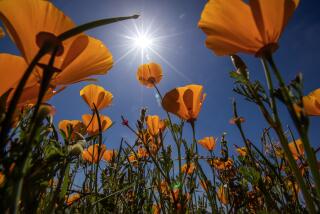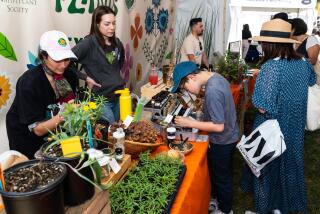Red Harvest : This Yearâs Poinsettia Crop Is the Best in Recent Years, Local Growers Say
While the ongoing recession may make for modest piles of presents under the Christmas tree this year, a bumper crop of poinsettia plants in Ventura County will ensure that much of the western United States is rich in red-hued blooms.
Area growers say much of the crop, which fetched more than $1.5 million in 1991, has already been shipped throughout California and the western United States.
But Ventura County growers also have furnished local supermarkets, garden centers and discount stores with pallets of the holiday plants in traditional rich red, creamy white and peppermint pink.
The warm summer with long days of full sunlight strengthened and colored the plants more this year than in many of the foggy summers of the past, growers said.
âItâs a prettier, fuller crop this year with better color and overall good quality,â said Ron Terry, general manager of California Plant Co. in Oxnard. Plants purchased now will last through the holidays with the right care and feeding, Terry said. But that would take some work, including proper watering with nutrients.
âWhen people buy poinsettias at Thanksgiving, I tell them they are really pushing the plant,â he said. Only half in jest, he added, âwhat weâd really like people to do is to buy one now and another one later.â
California Plant Co., a wholesale grower of several varieties on seven acres of hothouses along Gonzales Road, is one of at least eight nurseries in Ventura County that produce the annually blooming plant. Milgro Nurseries Inc. of Oxnard is the largest of the countyâs poinsettia producers, shipping half a million of the potted shrubs every year.
âThere are only 20 agricultural commodities in Ventura County that are worth more than $1 million, and poinsettias are one of them,â said Kerry Bustamante, deputy commissioner with the county agricultural commissionerâs office in Santa Paula. âItâs an important crop in our county.â
In the city of Ventura, where many yards are adorned with the blooming bushes, poinsettias are more than revenue and a flourish of color. In 1926, at the urging of the Chamber of Commerce, the city changed its nickname from the Palm City to the Poinsettia City, a title to which the city clings today.
For many years thereafter, the city gave away clippings to residents who wanted to start their own plants outside, said Yetive Hendricks, a 33-year Ventura resident who serves as a docent at the Ventura County Museum of Art and History.
In fact, parts of the city that are now shopping centers and main thoroughfares were once poinsettia fields, Hendricks said.
âWhen I was a little girl back in the â20s, we came to Ventura from Los Angeles on a Sunday drive,â she said. âAt Five Points (where Thompson Avenue, Main Street and Telegraph Road meet), it was just one big poinsettia field, acres and acres of them.â
The poinsettia, a native of Mexico, was named for the American diplomat Joel Roberts Poinsett. Poinsett brought the plant to the United States from Mexico during the 1820s.
In Mexican legend, a small boy knelt at the altar of his village church on Christmas Eve with nothing to offer but his prayers. Through a miracle, a poinsettia, known as the Flower of the Holy Night, sprang up at the boyâs feet in brilliant red and green. Impressed with the plant and its lore, Poinsett brought it back to his home in South Carolina and began cultivating it.
A member of the spurge family Euphorboaceae , poinsettias grow from two to 10 feet tall in the right conditions. The colored leaves are called bracts; the plantâs flowers are the small yellow buds in the center of the bractsâ clusters.
The bright potted plants now in area stores have been babied into the beautiful blooms that delight holiday shoppers. They have been intensively fertilized, the hours of light and dark manipulated, temperatures controlled and watered under a perfect regimen, all to produce the brightest, strongest and best-looking plants.
âThey are bred for show,â Terry said of many of the varieties available. âThey are not that hardy outside and will never look the same as they do now.â
But at least one variety, the Freedom, which was developed by the Paul Ecke Ranch in Encinitas, does very well when planted outdoors in the area, said Dianne Davis, vice president at Dorightâs Color, a wholesale nursery in Oxnard.
âItâs a brand-new plant with deep color--almost like a blue-red,â she said. Doright sells the variety to retail nurseries throughout the county, including Ecology Landscape and Nursery in Simi Valley, Armstrong Garden Center in Thousand Oaks, the Sanders Nursery in Oxnard and Green Thumb and Mound nurseries in Ventura.
To survive the transition from indoors to out, poinsettias should be kept in a sunny window until the chill is off the ground in the spring. Then they should be planted where they will receive full sunshine, but no artificial light from a nearby street light or living room window. That would interrupt the plantâs blooming cycle, which is triggered by the shorter days and longer nights of fall, she said.
âThey are very sensitive to light,â she said.






